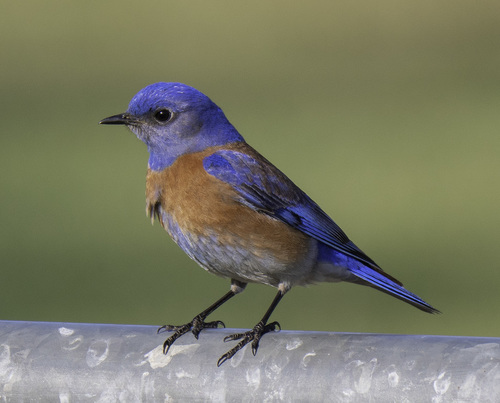
Western Bluebird
The Western Bluebird (*Sialia mexicana*) is a small, striking thrush found across western North America. Known for its brilliant blue plumage in males, it plays a vital role in its ecosystem by controlling insect populations and dispersing seeds. It's a cavity-nester, often relying on tree hollows or nest boxes. While not as widely recognized in folklore as some other bluebird species, the Western Bluebird is a welcome sight for birdwatchers and a symbol of the open woodlands and savannas it inhabits.
15-18 cm
Length
28-32 cm
Wingspan
Least Concern
Conservation Status
Distribution
The Western Bluebird's range extends from southwestern Canada (British Columbia) south through the western United States (Washington, Oregon, California, Nevada, Utah, Arizona, New Mexico, Colorado, Idaho, Montana, Wyoming) and into central Mexico. They are generally resident, but some populations undertake short-distance migrations, moving to lower elevations or further south for the winter.
Lifespan
The average lifespan in the wild is around 2 years, but some individuals have been recorded living up to 8 years.
Western Bluebird's Habitat
Habitat Types
Open woodlands, Savannas, Forest edges, Grasslands with scattered trees, Agricultural areas with hedgerows, Riparian corridors
Climate Zones
Temperate, Subtropical
Adaptations
Western Bluebirds are adapted to open habitats with perches for hunting. Their strong legs and feet allow them to perch comfortably on branches and wires. Their relatively short, pointed wings are well-suited for the short flights between perches and prey. They also have excellent eyesight to spot insects from a distance.
Variations
Several subspecies are recognized, differing slightly in plumage color and size. For example, *Sialia mexicana bairdi* (found in the southwestern US and Mexico) tends to have a more rufous breast than the nominate subspecies (*S. m. occidentalis*).
Appearance
Breeding Plumage
Males have bright blue upperparts, a rusty-orange breast and flanks, and a white belly. Females are duller, with grayish-blue upperparts, a paler orange breast, and a gray throat. Non-breeding plumage is similar, but colors may be slightly less intense.
Seasonal Feather Changes
Plumage coloration is brightest during the breeding season. After breeding, birds molt into a slightly duller plumage.
Sex Based Plumage Differences
Significant sexual dimorphism exists, with males being much brighter blue than females.
Notable Features
Bright blue plumage in males, Rusty-orange breast, White belly, Relatively short, rounded wings
Diet and Feeding
Primary Foods
Insects, Spiders, Berries, Fruits, Seeds
Foraging Behavior
Western Bluebirds are primarily insectivores during the breeding season. They typically perch on low branches, fences, or wires and scan the ground for prey. They then swoop down to capture insects, often hovering briefly before grabbing them. They also glean insects from foliage and occasionally catch them in mid-air. In the winter, they consume more berries and fruits.
Specializations
Their keen eyesight is crucial for spotting insects from a distance. Their perching and hovering abilities are specialized adaptations for their hunting style.
Seasonal Diet Variations
Their diet shifts significantly with the seasons. Insects are the primary food source during the spring and summer, while berries and fruits become more important in the fall and winter when insects are less available.
Behavior
Social Structure
Western Bluebirds are generally found in pairs or small family groups during the breeding season. Outside of the breeding season, they may form larger flocks, sometimes mixed with other bird species.
Communication
Soft, warbling songs, Chattering calls, Wing-waving displays, Chup calls
Migration
Most populations are resident or short-distance migrants. Birds in higher elevations or northern areas may move to lower elevations or further south for the winter.
Territorial or Group Behaviors
During the breeding season, males are territorial, defending their nest site and surrounding area from other bluebirds. Outside of breeding, they are less territorial and may forage in flocks.
Conservation
Threats
Habitat loss (due to logging, agriculture, and development), Competition with introduced species (e.g., European Starlings and House Sparrows) for nest cavities, Pesticide use (reducing insect prey), Climate change (altering habitat and food availability)
Protection Programs
Nest box programs (providing artificial nesting sites), Habitat restoration and conservation efforts, Monitoring of populations
Local National Laws
Protected under the Migratory Bird Treaty Act in the United States.
Population Trend
Generally stable, although some local declines have been observed.
Population Estimates
The global population is estimated to be around 6.8 million.
Interesting Facts
Western Bluebirds often reuse nest sites.
They may return to the same cavity or nest box year after year.
They can see ultraviolet light.
This ability may help them find insects and ripe berries.
They are known to hybridize with Eastern Bluebirds where their ranges overlap.
This hybridization is relatively rare but can occur.
They are important seed dispersers.
By eating berries and fruits, they help spread the seeds of various plants.
Faqs about Western Bluebird
What can I do to attract Western Bluebirds to my yard?
Provide open habitat with perches, install nest boxes, offer mealworms, and plant native berry-producing shrubs and trees.
How can I tell the difference between a male and female Western Bluebird?
Males have bright blue upperparts and a rusty-orange breast, while females are duller with grayish-blue upperparts and a paler orange breast.
Do Western Bluebirds migrate?
Some populations are resident, while others are short-distance migrants, moving to lower elevations or further south for the winter.
Are western bluebirds endangered?
No. Western Bluebirds are classified as 'Least Concern' by the IUCN.
Copyright @ Nature Style Limited. All Rights Reserved.
 English
English